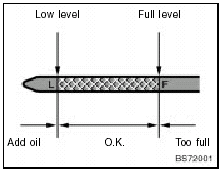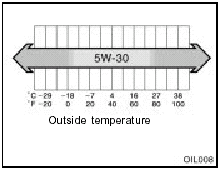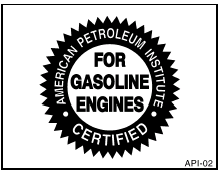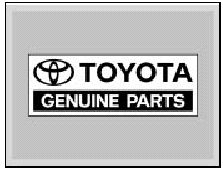 Toyota Yaris: Checking the engine oil level
Toyota Yaris: Checking the engine oil level

With the engine at operating temperature and turned off, check the oil level on the dipstick.
1. To get a correct reading, the vehicle should be on level ground. After turning off the engine, wait a few minutes for the oil to drain back into the bottom of the engine.
2. Pull the dipstick out, hold a rag under the end and wipe it clean.
3. Reinsert the dipstick—Push it in as far as it will go, or the reading will not be correct.
4. Pull the dipstick out and look at the oil level while holding a rag under the end.
CAUTION.
Be careful not to touch the hot exhaust manifold.
NOTICE.
Be careful not to drop engine oil on the vehicle components.
If the oil level is below or only slightly above the low level, add engine oil of the same type as already in the engine.
Remove the oil filler cap and add engine oil in small quantities at a time, checking the dipstick. We recommend that you use a funnel when adding oil.
The approximate quantity of oil needed to raise the level between low and full on the dipstick is indicated as follows:
1.5 L (1.6 qt., 1.3 Imp.qt.)
For the engine oil capacity, see “Service specifications”.
When the level reaches within the correct range, install the filler cap hand-tight.
NOTICE.
Be careful not to spill engine oil on the vehicle components.
Avoid overfilling, or the engine could be damaged.
Check the oil level on the dipstick once again after adding the oil.
ENGINE OIL SELECTION
“Toyota Genuine Motor Oil” is used in your Toyota vehicle. Use Toyota approved “Toyota Genuine Motor Oil” or equivalent to satisfy the following grade and viscosity.
Oil grade: ILSAC multigrade engine oil.
Recommended viscosity: SAE 5W-30.

SAE 5W-30 is the best choice for good fuel economy, and good starting in cold weather.
If SAE 5W-30 oil is not available, SAE 10W-30 oil may be used. However, it should be replaced with SAE 5W-30 at the next oil change.

Oil identification mark
The ILSAC (International Lubricant Standardization and Approval Committee) Certification Mark is added to some oil containers to help you select the oil you should use.

To ensure excellent lubrication performance for your engine, “Toyota Genuine Motor Oil” is available, which has been specifically tested and approved for all Toyota engines.
Please contact your Toyota dealer for further details about “Toyota Genuine Motor Oil”.
 Checking the engine coolant level
Checking the engine coolant level
Look at the see-through coolant reservoir when the engine is cold. The coolant
level is satisfactory if it is between the “FULL” and “LOW” lines on the reservoir.
If the level is low, add ...
See also:
Maintenance and care
Cleaning and protecting your vehicle, performing do-ityourself maintenance, and
maintenance information. ...
Auxiliary boxes
To use the auxiliary boxes, open the lids as shown in the following illustrations.
CAUTION.
To reduce the chance of injury in case of an accident or a sudden stop, always
keep the auxiliary box ...
General information
1. BASIC DIMENSIONS
(a) There are two types of dimensions in the diagram.
(1) (Three-dimensional distance).
Straight-line distance between the centers of two measuring points.
(2) (Two-dimensi ...

